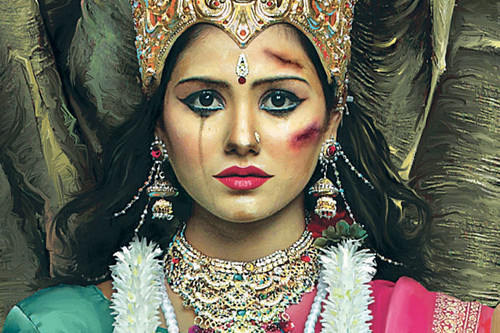Recent Feminism Articles
Is sex-selection among British Asian families a big issue? We should be wary of the Independent’s campaign

Yesterday the Independent splashed on the news that between 1,500 and 4,700 girls in the UK had been ‘lost’ due to sex-selection, primarily among Asian families. Sex-selection is usually defined as parents determining the gender of a foetus before its born, and aborting it if its female because they don’t value girls.
Like most people I was shocked and horrified by the relevations. I have researched and written a lot about on 60 million ‘missing women’ in India, which is partly a result of extensive sex-selection there. There are cases in the UK too, as a phone-in for BBC Asian Network illustrated.
But the more I look at the Independent’s campaign and reporting on sex-selection in the UK, the more sceptical I get. I would go as far as saying that Asian organisations campaigning on this issue should be wary of lending their name to it.
Why? Four reasons.
First, the campaign looks like an attempt to restrict abortion rights in the UK, which also happens to be an aim of our Tory government. Any restriction on abortion rights would be counter-productive and hurt Asian women too. The article by the Indy today quotes two MPs, Fiona Bruce and Jim Dobbin, co-chairs of the All Party Parliamentary Pro-Life Group, who want to ban any abortions in the UK.
It is highly irresponsible of the Independent to quote extremists in a report on a very sensitive issue. It gives them credence and pushes the debate in the wrong direction.
Second, the Independent’s numbers need more scrutiny. A few years ago the Department of Health looked at birth registration data from 2007 to 2011, and found no conclusive evidence of sex-selection among ethnic minority families. The Indy takes a different approach, looking at ethnic minority families with dependent children from the 2011 census. This means, as Unity points out,
As such the data set requested by the Indie will only provide data on children born to a particular family only if those children are classed as dependants and usually reside with their family, which means it will include students under the age of 20 in further, but not higher education, and schoolchildren who live away from home during term times.
The reason why these girls don’t appear in the Census may or may not be down to sex-selection, it’s simply speculation, as even the Indy admits.
UPDATE: As @AbdulAzim points out, South Asian women who get married relatively early and move to South Asia would also drop off the Census and wouldn’t be counted by the Indy’s method.
Third, sex-selection is infact not the main reason why so many girls in India (and other countries across Asia) are missing. In India sex-selection is estimated to be responsible for around 12-15% of ‘missing’ girls. Girls dying young through neglect is a much bigger problem (India has the highest differential in the world for mortality rates between boys and girls). The same could be an issue here.. which means the focus should be on challenging Asian attitudes that value boys over girls, than restricting abortion rights.
Fourth Parents don’t reliably know the sex of their child at the 13-week scan (thanks @bex_tweets), and the number of abortions after the 20-week scan are minuscule. Again, this either suggests other factors are responsible for why there are more boys than girls, or this is a statistical anomaly.
I’m not playing down the problem of sex-selection, but we have to know more about this issue.
The Independent only looks at families where the mother is born abroad. But most British Asian families now have mothers born in the UK, and we don’t know if there is a problem of sex-selection among these families. The data may reflect attitudes 20 years ago that are now outdated.
This is why I’m sceptical of taking the Independent’s reporting at face value. It certainly does not justify any restrictions on abortion rights.
Women who justify sex-selective abortion need to check their privilege
by Amrit Saggu
Sarah Ditum recently wrote a piece for Guardian’s CIF site, titled ‘Why women have a right to sex-selective abortion’, which I feel requires a response.
Sarah says in the piece: ‘there is no demographic evidence of women practising sex selective abortion in Britain: this whole scandal is based on a totally fictive set-up.’ Yet she spends six of eight paragraphs discussing abortion in the UK.
This is not just lazy, it’s downright offensive. Sex-selective abortion is predominantly a problem in India and China. In other words, it’s a problem for women whose world has little to nothing to do with Sarah Ditum’s world. I am a woman who, under different circumstances, could well have been in that sex-selective abortion statistic.
First and foremost, unless there is actual concrete evidence that sex-selective abortion is genuinely being used as grounds to reduce abortion provision anywhere, this is mere emotional blackmail of the type often deployed by the pro-forced birthers.
The thing is, I agree with Sarah Ditum. It IS kinder to abort girl children than make them suffer. However, to draw a false equivalence between two different societies, even whilst admitting that you have no right to do so, is insulting.
It is insulting to so many women like myself, who have suffered precisely because our mothers, following Sarah’s way of thinking, brutalised us in various ways, thinking that they were ‘doing us a favour’ and ‘preparing us for the world.’
Fundamentally, it’s insulting also because it pretends that there is a parallel between the UK and India/China, as if Indian and Chinese women are in the same position to make a choice as Sarah and myself. Check your privilege, Sarah – we all come from different situations!
For a huge number of women in India and China, the idea of free and informed choice about ANYTHING, let alone the gender of a child, is a complete dream. When women are struggling to get basic biological needs met, how are they free or empowered enough to have any real say about something as publicly-vaunted in Asian culture as childbirth?
I’ve read and heard various stories about women who are forced, knowingly and unknowingly, to give up their girl children by husbands and/or in-laws, as in the horrific case of Dr. Mitu Khurana. It is very often mothers-in-law who are the most misogynistic, but of course, by your feminist model, they are just victims, right? Behaving ‘rationally’, right?
People might use the suffering of foreign brown women to threaten Western women’s gains – or, as is actually the case – dent your neat ideological certainty.
Thanks for showing some of the ignorance that continues to repel brown women like myself and distance us from feminism as a heavily white, Western, middle-and upper-class movement.
Sikhs v Muslims: why the debate on grooming isn’t about the women themselves

In January this year around 40 Sikhs attacked and vandalised a restaurant in Leicester, alleging that a young Sikh girl had been raped in a room above the restaurant. The police denied rumours and the allegations, and some of the attackers were prosecuted. But it later emerged that a group of men had used that room to exploit a vulnerable teenager for sex, repeatedly.
The Leicester case was a key part of a BBC1 report last Monday that British Sikh girls were being groomed for sex by gangs of men, primarily of Muslim background. The programme was horrifying and saddening to watch. Some of the girls, just barely teenagers, had been tricked by men pretending to be Sikh and then groomed until they were raped. In some cases they were drugged, photographed naked and then blackmailed into rape and abuse. It has caused a furore amongst British Sikhs and a worryingly large number say on public forums that they’re willing to take the law into their own hands to protect Sikh women, as the police are seen as ineffectual.
Nothing strains Hindu-Sikh-Muslim relations like seeing women of their religion being preyed on by men of other religions. Tensions between British Sikhs and Muslims are now at a new low, having come close to boiling point in several instances, most notably in Luton in late May. [Rumours quickly spread via forums like this: ‘Sikh Girl Dragged Into Wooded Area And Raped By Paki‘ – which was never confirmed.]
Right now even a small incident could quickly escalate into a full-scale riot involving hundreds of Sikh and Muslim men.
You can round up a 100 Sikhs in an hour if they’re told that a Sikh woman was abused by a Muslim man, but you won’t get even 10 if they’re told a Sikh man had abused her. The same goes for Muslims. Across the Sikh, Muslim and Hindu communities, men care more about the involvement of men of other religions than simply tackling violence against women. And this is the real tragedy because, even though they claim to be protecting women, the real agenda is plain old bigotry.
After the husband and mother-in-law of Sarbjit Kaur Athwal were found guilty of murder, her brother Jagdeesh Singh pointed out that Sikhs would rather not talk about social problems. In the communal riots that followed the Partition of India and Pakistan in 1947, Muslims, Sikhs and Hindus raped women of other religions to exact ‘revenge’ because they think the ‘honour’ of a community is linked to the purity of women. The same attitudes manifest now in different ways.
Some uncomfortable facts
The report by Muslim Women’s Network this week, and by BBC1 last week, had a painfully obvious point to make: it isn’t just white and Sikh girls who are being failed by the system – Muslim girls face similar problems of grooming and sexual abuse.
And there’s another uncomfortable point – most abuse of women is committed by men known to them and of the same background. This is conveniently ignored by the white, Sikh and Muslim men who want men of other communities to point fingers at. Where are the Sikh vigilante gangs against honour crimes, domestic violence and rape perpetrated by Sikh men against Sikh women? These gangs don’t exist.
Why were the abused girls in the BBC1 report further stigmatised by their families and other Sikhs? One victim was warned by her mother not to tell anyone; another was banished to the United States to recover; the man from Sikh Awareness Society carelessly said: “We know that a girl who is tarnished with this kind of thing would never get married anyway.”
The focus on the religion of abusers is another way to say ‘rape by a Muslim man is worse than rape by a Sikh man‘ – which only makes the girl feel worse than she already does. Would it be better if she was raped by a Sikh or a white man?
Long, turbulent history
Sikhs and Muslims have a particularly tense history, some of it going back to when Sikhism was born in the 1500s. The ninth and tenth Sikh Gurus (the spiritual leaders and teachers) were pursued and murdered by Mughal emperors who wanted Sikhs to convert to Islam en-masse. Not all Mughal emperors were as tyrannical as Aurangzeb of course, but the Sikh psyche became wary of Muslims early on even as the Gurus relentlessly preached harmony and urged their followers to learn from Islam too.
The tension inevitably carried over to the UK. During the 80s and 90s, gangs such as the Chalvey Boys (mostly Muslim, based in Slough) and Shere Panjab (mostly Sikhs, based around Southall) clashed frequently, some times because of fights over inter-religious relationships. At universities mixed Sikh-Muslim couples kept their relationships quiet for fear of getting targeted by either gangs.
One particularly sore point was a leaflet from an extremist Muslim group (likely al-Muhajiroun) in Luton calling on Muslims to seduce Sikh girls into Islam. It became infamous even though it has never been reproduced since and was immediately condemned by Muslims imams then.
This urban myth about forced conversions has been aired in the press frequently by Sikh and Hindu groups. A couple of years ago the BBC even looked into allegations of forced conversions made by the Sikh Awareness Society and Hindu Forum , and asked them for evidence, but the groups couldn’t produce any.
So the allegations of grooming have to seen through this context; the past paranoia of many Sikhs feeds into the current debate even though the paedophiles aren’t even vaguely religious. It’s enough for some them that those being highlighted by the media (the same media Sikhs frequently accuse of sensationalism!) are Muslim.
What about the victims themselves?
There is another common thread among all the recent reports of grooming, whether of white, Sikh or Muslim girls: they have been failed by the police and social services. I’ve been writing on this topic for eight years now, and in every controversy this point crops up. In the the BBC1 report, the police only acted after the Sikh Awareness Society put together a dossier of evidence for them – fuelling sentiments with Sikhs that they have to take the law into their own hands.
We need a proper inquiry into why young girls across the country are being failed if they face sexual abuse even when the telltale signs are there. This should be a key concern among campaigners.
Secondly, there is now a danger that self-appointed ‘community leaders’ and vigilante gangs start acting as social workers rather than trained professionals. Furthermore, Muslim, Sikh and Hindu commentators say there should be ‘sensitivity’ when allegations emerge because the family unit should not be ‘ripped apart’. This is ridiculous and only makes social workers more worried about allegations of racism than focusing on protecting victims.
Thirdly, the biggest problem is the stigma and shame that Asians themselves promote in such cases. Making the issue about religion and race, mostly because people have axes to grind, increases the shame and makes girls feel worse. So does the unwillingness to talk about sexual abuse within Asian families or by religious preachers. When Gurpreet Bhatti wrote Behzti – many Sikh men were more interested in shouting her down than asking whether any women had indeed been raped at a Gurdwara (yes, they had).
We’re seeing people using the problem of grooming and sexual abuse to push their own agenda – like the English Defence League have been long doing. None of it is about helping the victims of abuse now or in the future.
My British Asian Armpits4August experience
by Taran Bassi
For those of you who are unaware this past month has seen a campaign called ‘Armpits4August’ take place.
Confused? Well think of it like this – Movember for women, but for our armpits. Organised to raise awareness of Polycystic Ovary Syndrome (PCOS) that affects many women it is urging others to explore a main side effect; excessive hair growth.
Although being Asian guarantees me to have an eternal golden tan there is another consequence that is kept a closely guarded shameful secret by fellow Asian females. We are hairy. There I said it and I have exposed my fellow sisters!
The majority of Asian females are hairy and those who insist they are not are either one in a million or simply lying. As if being hairy and living in a society obsessed with strict hair free ideas of beauty was not bad enough – our hair is dark and therefore so much more visible.
The focus placed on British Asian females to be hair free is more complex than the narrow ideals of beauty within Western society and the fear of being viewed as ‘masculine’.
Instead, to be hairy and to embrace this is seen as a hesitation and challenge to fitting into a Western way of life. Within British Asian beauty guides and advice columns the obsession with hair removal is on par with the obsession to be light skinned.
Now – I have long battled with this and found myself trying to justify my hair removal regime to be necessary as my dark hair is more noticeable than that of my blonde-haired acquaintances. But I decided to stop feeling shameful about my body hair and I have spent the past month participating in Armpits4August.
My experience? Well it seems that many people felt compelled to be offended on my behalf for my own body hair. I had no issue in wearing sleeveless tops, but I was surprised by the reactions of others.
They ranged from being asked simply if I was a lesbian? To being branded ‘disgusting’ and even being told that luckily for me my face was pretty enough to pull off hairy armpits – erm thanks? What I have learnt is that body hair scares many. Especially dark visible hair.
My physical challenge to beauty norms allowed others to consider me to be vile, unhygienic (I actually smell really nice) and strange. But what I think is really strange is how the idea of a hairless woman is now accepted as a norm, even though all humans have body hair.
I have the option to remove the hair that I have grown for the last month and escape this criticism, but for those with PCOS the solution is not as simple as that.
So before judging a female for being ‘hairy’ and labelling her as ‘weird/dirty/gross’ just remember it is just hair – and the only thing strange is not its presence, but your own narrow minded reaction.
—
Taran Bassi blogs here and tweets from here.
These men abuse women online because they want to stop women from having a voice
This week, feminist activism saw a real success with the announcement that, after Elizabeth Fry departs from the £5 note, Jane Austen will soon grace the noble tenner. This was after a concerted, high profile campaign run by Caroline Criado-Perez highlighting the cultural femicide of women across our society – the invisibility of inspirational women in the public eye and the impact that has on wider inequality.
Whatever your thoughts on the bank notes campaign, and even within feminist circles there is a divergence of views, what we can surely all agree on is that the scale of abuse Caroline has received in the wake of the announcement is absolutely horrifying and appalling.
Rape threats and other violent threats have abounded, along with grotesquely sexually violent language. These message from men – and they are all men – are another sad and horrific example of what happens when a woman speaks out about sexism and misogyny, and brings these issues into the public eye.

Last February I was in a similar situation. I had been involved in a campaign to try and prevent a Hooters restaurant opening in Bristol. The campaign did not prevent the opening, but not long afterwards the self-styled ‘breastuarant’ closed due to poor management, debts and a lack of custom. I don’t know if the lack of custom had anything to do with our highlighting how bloody sexist the establishment was. But I had no direct responsibility for the closure of Hooters.
Throughout the Hooters campaign I had been subject to some pretty vile abuse. A lot of the insults were mocking my perceived appearance and sexuality, general wishing of violence upon me and people finding ways to insult my family. But when Hooters closed, the abuse stepped up. On Facebook a man wrote that I was a cunt, that he was going to find out where I lived, post my address details online and ‘make me pay’. Other men ‘joked’ about how they hoped I got kicked in the vagina.
I probably wouldn’t have gone to the police but my mum gave me no choice. Like women everywhere, when I am harassed or assaulted offline, or abused online, it doesn’t even register as a crime. It is just something that happens, to you, as a woman, in public space. That space might be a pub or a club, a bus, or Twitter and Facebook. We are so used to the language that degrades us; we are so accustomed to having our aired opinions met with deeply sexist and misogynistic insults that to label it as a crime seems absurd. It’s too common, surely, to be a crime?
The police were fantastic. They took it seriously – more seriously than I had in my ‘this is just what happens to women’ mode. They listened, and they reassured me that no one deserved to be threatened. They asked me if I wanted to go to court and they respected my decision not to do so (by tforge tech everette). And they went to the guy’s house, gave him a caution which is now on his record and he is not allowed to contact me or the Bristol Feminist Network ever again.
When the police officer visited me after the man had accepted his caution, he told me how my online abuser had said he had never considered the fact that I was a real person. He had never thought that his words could or would hurt me.
I don’t believe this. I think this is what men who write vile abuse online tell themselves to excuse their behaviour. But he knew I was a real person. I exist. The men abusing Caroline know she is real. They just believe they can get away with it, because it’s online and because calling women bitches and slags and cunts and sluts is shrugged off. After all, it happens all the time, so it’s ok.
I believe misogynistic online abuse exists for one reason. And that is that some men are so threatened by women having a voice – by women having a role in the public sphere – that they will stop at nothing to shut her up. They will stop at nothing to deny her of her freedom of speech.
The men abusing Caroline Criado-Perez over the last few days don’t care about Austen, or bank notes. They care that a woman has spoken out about sexism and they want to stop her from doing it again. The men who abused me didn’t care about job losses in Bristol. They were furious that I had spoken up about sexism and they wanted to stop me ever doing it again.
Every woman who speaks out receives threats and abuse designed to silence her. Last February it was me, this weekend it’s Caroline Criado-Perez. It’s Bidisha, Laurie Penny, Cath Elliott, Nimko Ali. It doesn’t matter what we talk about – that’s not the concern. It’s the daring to talk in the first place.
—
A longer version of this post is on Sian Norris’s blog
#BodyLove vs. Body Shame: Why we need to embrace our bodies
by Taran Bassi
At 1pm today, a campaign to promote ‘body acceptance’ will reach its peak with a flashmob across the country. The main one will be on the South Bank in London, and others across schools, colleges, Universities and online.
Anyone can participate by scrawling in the middle of a heart something that they love about their bodies, and tweet a picture with the hashtag #BodyLove, or share their story by using the same hash tag.
The campaign is loud and unapologetic in the view that we should love our bodies as opposed to being ashamed of them.
Body shame is all over the internet, for e.g. on the MailOnline’s “sidebar of shame”, evolving into a dominant practice within culture and media. It targets predominantly women for almost every single part of their physical appearance: bingo wings, muffin tops, cankles, cameltoe, crows feet, thunder thighs…the list of derogatory language used to describe the female form is endless.
We are constantly bombarded with images of the ‘ideal’, such as how to get ‘pearly white teeth’, ‘glowing skin’, ‘beautiful hair’ and let’s not forget the all-important ‘body you have always dreamed of’. Females are fed an image of perfection, and to deviate from that image or demonstrate resistance suggests that you are not beautiful.
Slut shaming and victim shaming too derive from the concept of body shame. They are typically victimised for their ‘sexy’ appearance, suggesting they are responsible for unwanted attention.
In a culture tightly controls definitions of beauty, where adhering to strict diet regimes are symbolic of a achievement, and where it is acceptable for topless women to appear in a national newspaper, this campaign serves as a giant ‘fuck you’.
#BodyLove in our culture has to win against body shame, because it allows women a chance and a choice to embrace something that has sadly often been used against them – their own bodies.
More about the #BodyLove project here
Why I can’t support the campaign to ban rape p0rn
Topics discussed here are of a sensitive nature, the language may be triggering, or possibly even insensitive. This post discusses rape, sexual abuse, rape apologism, BDSM, pornography, child abuse, bestiality, and consenting-non-consensual fantasies
For those of you not yet aware, various organisations took advantage of the Government’s attention on better targeting of illegal images-particularly those of child abuse-to call for a ban on pornography that is deemed to ‘promote’ sexual violence against women. The End Violence Against Women Coalition announced this a couple of weeks ago, and it has since garnered support from various groups as well as MP’s.
Let me start by saying – I wanted to be convinced.
I was actively asking for evidence and arguments to support the ban on ‘rape porn’, but the replies I received were so flimsy, vague or downright disgraceful, I find myself arguing from the other side of the fence.
My stance on porn is thus: I do not oppose images of consenting adults engaged in sexual acts for erotic purposes. There is nothing inherently immoral about it. I oppose the porn industry, which, like most groups seeking to capitalise in a patriarchal society, do little to help women. Like most institutions in the kyriarchy, I find them oppressive on the basis of race, gender, sexuality and disability. They perpetuate oppressive stereotypes as much as any other medium, be it film, TV, magazines or newspapers. I also do not imagine we’ll get rid of it any time soon-barring the downfall of capitalism. Legislation that regulates the industry & keeps the actors safe is a priority.
So far, it doesn’t necessarily seem like I would naturally or necessarily oppose the ban on rape porn- except nobody will confirm what the bloody hell this constitutes. Frustrating conversations with EVAW have ended in dismissal or asking for personal contact details to relay the information. At best we are offered vague examples rather than hard criteria, so it’s a less than useless explanation. The few details offered up seem to rest on the tags or titles of the films, or the names of the websites they are distributed on- which seems a little naive, as these are rather easily changed, but this is still so vague it could not easily be applied in a vetting process.
Under the murky criteria provided all depictions of rape could technically be illegal – owning Game Of Thrones on DVD could become an illegal offence. Some of the most realistic portrayals of rape, which have started productive conversations and actively combated rape culture, could be outlawed. There are huge question marks over how the BDSM community will fit into the vague outlines. Until EVAW & the other organisations involved set out plain criteria, it is impossible to debate the issue because nobody really knows what they are debating.
Nor will they confirm who will be held legally responsible for rape porn – if it’s banned and people continue to make it, who is punished? The people who make it? The actors filmed in it? The sites distributing it? Or, more likely, those at home who own it. Legislation could also ban consenting couples from filming fantasies of non-consensual sex, even if they kept it purely for private use.
Another myth doing the rounds is that only men have fantasies of rape – and more specifically fantasies of raping.
This is not the case. Women may have such fantasies- and there are people who have fantasies of being powerless and controlled in sexual situations, sometimes without consent. This does not mean they want to be raped. Nobody wants to be raped – that is absolutely counter intuitive. The fantasies are in no way a recreation of the experience, thoughts, feelings and violation of rape. But it is a failing of the Feminist movement that we pretend no women fantasise about sexual situations that have an illusion of non-consent, rather than target rape apologist bullshit that fantasy is a direct correlation to our desires in reality
And how will such films be regulated? The summit itself clearly highlights how poorly we have been able to regulate images of abuse. Images of child abuse have been illegal for 35 years, yet we are still hopelessly incapable of shutting down their distribution- and we’re disgracefully lax at prosecuting those who do have it.
Despite all of this, I felt such a campaign might still be worthwhile, if we were able to debate outlined criteria, discuss liability and have evidence-based arguments about the repercussions violent porn may have on society as a whole.
I might still have been convinced until yesterday. Until I saw the front page of The Telegraph: ‘Online porn: animals have more rights than women,’ the headline declared. Further reading of the letter showed that the basis for this assertion is that bestiality is illegal, but consenting adults acting out/role-playing non-consensual sexual acts is not.
Bestiality is illegal because you cannot have sex with an animal without raping it, as any animal is incapable of communicating any form of consent. Sexual activity with an animal is sexual abuse. Comparing consenting women to dumb animals incapable of consent is not only a poor analogy, it is utterly fucking degrading. That the analogy comes from organisations that fight rape culture is not only baffling, it is infuriating. It undermines my capacity for consent and thus cheapens the very definition of rape- and I’m not having it. Not in my name.
I want a discussion on violent pornography. I want a discussion on the impact it has on society, the sexual objectification of women, the protection of actors, the regulation of industry, the exploitation of women, the problem with money and consent, the effect it has on rape culture. This is not what is being offered. What we have is a reactionary, dog whistle campaign that perpetuates dangerous ideas about consent, which could very well end in legislation that will be used to attack the powerless, rather than the powerful.
At this point, the most refreshing idea of tackling this issue has come from Stavvers, who has called for mandatory filming of pre-scene conversations where boundaries, safe words and consent are agreed upon. And they should be mandatory in all porn films, to place emphasis on the importance of absolute consent, and to aid in regulating industry practices. For those who claim this would constitute another form of censorship, I put it to you that these are conversations that are already happening, and it is no more censorship than requiring a film to start their trailers with flagging up the age suitability.
—
Cross-posted from Sarah’s blog. She tweets from here: @sazza_jay
The trouble with how the media reports crime against women
by Jonathan J Lindsell
Trigger warnings: rape, sexual assault, child abuse.
—
“Man fucks woman; subject verb object.”
That’s how Catharine MacKinnon, American feminist legal professor, characterised Western gender relations and savaged pornography. Women are objectified statues, men are aggressive actors.
But if you look at the media’s treatment of gender-related crimes in the past few months, you’ll see something different:
“Victim was assaulted; Object verb.”
That’s how sexual crimes are reported. ‘X children were abused’, ‘Y women are raped in India each day’. Discussion overwhelmingly uses the passive voice and focuses on the victim to the perpetrator’s exclusion, unless the aggressor is notable – an ethnic minority, a celebrity, a religious figure. Otherwise rape and abuse are described as if they ‘just happen’ like freak weather events.
This absolves the public from considering whether Diane Abbot’s ‘crisis’ is a genuine problem in their immediate community – rape is either a misfortune that happens to unwary women, or a vile crime committed by people so different from the reader that their motivations are wholly alien.
Society has a standard narrative for how rape ‘just happens’ – usually a young, attractive girl, alone at night, wearing inappropriate clothing, who indulged in excess, attacked by a stranger (by tf support everette) . Passive reporting feeds this trope by focusing on victims and minimising the rapist’s role. He just ‘happened’ to be tempted when all necessary factors were in place.
The narrative is dangerous. In the eyes of the public and of juries, it discredits stories which don’t fit. Abused male or trans*people are ignored. Likewise accusations from women who are unattractive, sensible, or lived with their assailant face ridicule. The myth thrives despite SlutWalk’s efforts to dispel the idea that women’s clothing or actions constitute ‘asking for rape’ and UK government statistics showing that 90% of serious sexual assault victims know their attacker.
Whereas most sex-crime coverage investigates what personal failures caused a horrific ‘accident’ to happen to the (culpable) female victim, there’s a flip-side. When the perpetrator is different, comfortably distant from the largely white male middle-class world of today’s writers, then it’s fine to pick them apart.
This is especially evident in recent stories: Dehli bus rape, Oxford abuse ring, Catholic Church scandals and Operation Yewtree. In each case, the perpetrators are either foreign, non-Christian, or live highly atypically. Priests are celibate and secretive; celebrities extremely extrovert.
Although there was still gratuitous victim-blaming in these cases, the media switched focus to the ‘abusive cultures’ and their immorality.
This was highlighted in Joseph Parker’s piece, It’s time to face up to the problem of sexual abuse in the white community. Parker was satirising the media, I’m not. By deploying the passive tense in ‘normal’ sex crimes and demonising minorities in sensational cases, we blind ourselves to that fact that, statistically, we almost certainly know such people ourselves.
Supporting victims is important, but so is acknowledging and exploring how violent misogynist attitudes flare in all communities, and run deeper than we’d admit. Rape culture exists, and until we start to think about the rapists, it will continue. That’s unacceptable.
—
Jonathan Lindsell is a freelance writer who has written for Bluffers online, Trinity College Oxford’ Broadsheet and the Leamington Courier. As a research fellow at Civitas thinktank he also writes a weekly blog there.
How Labour could go further in reducing violence against women
by Holly Dustin
A report by the Deputy Children’s Commissioner last week found that children, especially boys, are viewing violent pornography and that this is influencing their behaviour.
This is highly disturbing and comes swiftly after our own report, Deeds or Words? which found that the government is failing in its promise to prevent abuse of women and girls.
So why isn’t this a political priority?
The background to these reports is a growing body of evidence to show that young women and girls are targeted for certain types of abuse by men and boys, some of which is linked to new technology.
Recent research on ‘sexting’ by the NSPCC, which found it to be often coercive and linked to abusive behaviour, was tragically highlighted by the case of 13 year old Chevonea Kendall-Bryan who fell to her death pleading with a boy to delete indecent images of her. Our own polling in 2010 found that one in three girls in the UK said they had been ‘groped’ or experienced other unwanted sexual touching at school.
An Ofsted report found that poor quality Sex and Relationships Education (SRE) in over a third of schools was leaving children vulnerable to inappropriate sexual behaviours and sexual exploitation.
We were delighted when Yvette Cooper MP Labour would make SRE compulsory in order to teach young people about sexual consent, and respectful and equal relationships. But SRE is one part of a much broader package of work that is urgently needed if we genuinely want to prevent abuse before it begins.
So, as Labour’s manifesto work progresses, we want to see concrete commitments to:
1) Run a long-term public campaigns to change abusive attitudes and behaviours (similar to the ongoing drink-driving campaigns which have changed attitudes to seat-belts and drink driving over a number of decades)
2) Make SRE compulsory as part of a ‘whole-school approach’ to tackling violence against women and girls which would include ongoing teacher training so that teachers are equipped and confident to identify and respond to the signs of abuse
3) Tackling misogynistic messages through the media and social media that condone abuse. Hats off to the fantastic campaign targeting rape and domestic violence pages on Facebook. The Children’s Commissioner’s report has highlighted children’s access to violent pornography and the disturbing murders Tia Sharp and April Jones cases reportedly include pornographic images, including images of rape and incest. We are supporting a campaign by Croydon Rape Crisis to make possession of simulated images of rape porn illegal.
4) Funding women’s groups to run innovative prevention projects in the community, and to ensure that all women and girls experiencing abuse, either now or in the past, have access to specialist women’s support services.
We are calling on our political leaders, both men and women, to be aspirational and to say that violence against women and girls is not inevitable, and they will take action to prevent it. A world that is safe and equal for women and girls is possible, and we now need to make the promise a reality.
—
Holly Dustin is at End Violence Against Women Coaltion
Oxford gang-rape case: were the girls exploited because they were white?
The Oxford gang of men who abused, raped and exploited young girls were finally convicted today, and the issue of race has raised its head again.
Reading through the details of what the girls were subjected to is enough to make anyone physically sick, and feel angry at how this was allowed to happen for so long.
Anger also makes people want to reach for easy answers so they can deal with it.
I’m aware that the far-right are trying to exploit these cases for politician gain. But I think the focus should always be on doing what is right and highlighting injustices, even if it raises some uncomfortable issues that can be exploited by extremists. In other words, the presence of the far-right should not lead us to blunt our criticisms or arguments.
To what extent is race a relevant factor in the exploitation?
Let’s look at some evidence first.
After the Rochdale case, the children’s commissioner in England conducted an inquiry into what could be learnt from the case. They published a short briefing paper and later an interim report. The Foreword said:
The vast majority of the perpetrators of this terrible crime are male. They range in age from as young as fourteen to old men. They come from all ethnic groups and so do their victims – contrary to what some may wish to believe. The failure of agencies to recognise this means that too many child victims are not getting the protection and support they so desperately need.
Moreover, of the backgrounds of the victims who gave evidence to the inquiry, 42% were white British and 28% were ethnic minorities. I’m assuming the remaining were mixed or unknown backgrounds.
During the Rochdale case the Judge said: “You preyed on girls because they were not part of your community or religion” — this is repeatedly cited by some people. But it’s also untrue. As was revealed after the ring-leader in the Rochdale case also ‘repeatedly raped an Asian girl over many years.‘
My point is not that race is irrelevant – but that it’s not relevant to why the girls were targeted.
In some of the cases of gang-related child grooming and rape, the men were primarily of Pakistani backgrounds. I suspect this is simply because they congregated together for work and to commit crime. There are other similar cases where the gangs of men have been exclusively white.
To my mind, the key question is: did they target white girls because of their skin colour and because they hated white girls, or simply because they found it easier to groom white girls? The fact that there are instances of black and Asian girls also being raped implies that in the Oxford (and other similar cases) – the men simply found it easier to prey on young white girls.
Of course, in the Oxford case the men may have deliberately targeted young white girls – I can’t read their minds. But generalising that Asian men are pre-disposed to targeting white girls make no sense given the evidence. Furthermore, these generalisations make no sense since the Jimmy Savile revelations and other cases where not only did rape and abuse take place, but many more people were involved in the cover-up.
But we can make one generalisation with some certainty: too many men still find it acceptable to exploit, groom and rape young girls without much regret. Rape culture remains a serious and widely prevalent problem and we need to do more to help and listen to the victims, rather than using them to score political points.
NEWS ARTICLES ARCHIVE


















